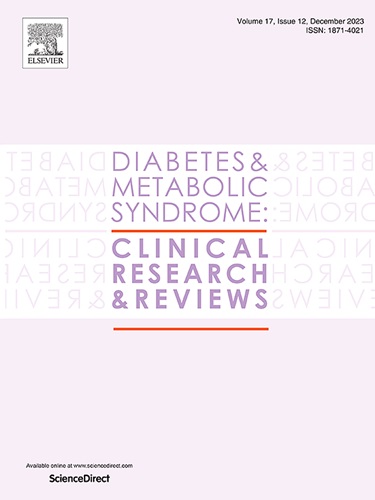The role of melatonin and circadian rhythms in the pathogenesis of diabetic retinopathy: A systematic review
IF 3.4
Q1 ENDOCRINOLOGY & METABOLISM
Diabetes & Metabolic Syndrome-Clinical Research & Reviews
Pub Date : 2025-02-01
DOI:10.1016/j.dsx.2025.103202
引用次数: 0
Abstract
Aims
This review investigates literature on systemic melatonin levels and circadian timing in diabetic retinopathy (DR), examining their associations with DR.
Methods
Our search was conducted in March 14, 2024, and included the databases Medline, Web of Science, Scopus, ProQuest Health, Latin American and Caribbean Health Sciences Literature (LILACS), Cochrane, International Standard Randomised Controlled Trial Number (ISRCTN) registry, and International Clinical Trials Registry Platform (ICTRP).
Results
Our review analysed twelve articles measuring melatonin concentration in saliva, blood serum, urine, or aqueous humour. Studies measuring melatonin levels in saliva found no significant differences in the average nocturnal or daytime melatonin levels between type 2 diabetes (T2D) patients with and without DR. The studies comparing serum melatonin levels in patients with different stages of DR and controls showed inconsistent results. Only two studies measured the endogenous onset of melatonin secretion, known as dim light melatonin onset (DLMO), a highly accurate biomarker for circadian regulation. These studies showed that only 33% and 57% of patients with DR had detectable DLMO in saliva and serum, respectively. All studies evaluating overnight melatonin production using urinary aMT6s (urinary 6-sulfaoxymelatonin) levels found that DR was associated with lower nocturnal melatonin production.
Conclusions
Our review results showed evidence of reduced nocturnal melatoin production in DR with no significant changes in melatonin circadian timing.
褪黑激素和昼夜节律在糖尿病视网膜病变发病机制中的作用:一项系统综述
本综述调查了关于糖尿病视网膜病变(DR)的全身褪黑激素水平和昼夜节律的文献,探讨了它们与DR的关系。方法检索于2024年3月14日进行,包括Medline、Web of Science、Scopus、ProQuest Health、拉丁美洲和加勒比健康科学文献(LILACS)、Cochrane、国际标准随机对照试验号(ISRCTN)注册库和国际临床试验注册平台(ICTRP)数据库。结果本综述分析了12篇测定唾液、血清、尿液或体液中褪黑激素浓度的文章。测量唾液中褪黑激素水平的研究发现,有和没有DR的2型糖尿病(T2D)患者夜间和白天的平均褪黑激素水平没有显著差异。比较不同阶段DR患者和对照组的血清褪黑激素水平的研究显示,结果不一致。只有两项研究测量了褪黑激素分泌的内源性开始,即昏暗光线褪黑激素开始(DLMO),这是一种高度准确的昼夜节律调节生物标志物。这些研究表明,分别只有33%和57%的DR患者在唾液和血清中检测到DLMO。所有评估夜间褪黑激素生成的研究都使用尿液aMT6s(尿6-亚砜褪黑激素)水平,发现DR与夜间褪黑激素生成降低有关。研究结果显示DR患者夜间褪黑素分泌减少,但褪黑素昼夜节律无明显变化。
本文章由计算机程序翻译,如有差异,请以英文原文为准。
求助全文
约1分钟内获得全文
求助全文
来源期刊

Diabetes & Metabolic Syndrome-Clinical Research & Reviews
ENDOCRINOLOGY & METABOLISM-
CiteScore
22.90
自引率
2.00%
发文量
248
审稿时长
51 days
期刊介绍:
Diabetes and Metabolic Syndrome: Clinical Research and Reviews is the official journal of DiabetesIndia. It aims to provide a global platform for healthcare professionals, diabetes educators, and other stakeholders to submit their research on diabetes care.
Types of Publications:
Diabetes and Metabolic Syndrome: Clinical Research and Reviews publishes peer-reviewed original articles, reviews, short communications, case reports, letters to the Editor, and expert comments. Reviews and mini-reviews are particularly welcomed for areas within endocrinology undergoing rapid changes.
 求助内容:
求助内容: 应助结果提醒方式:
应助结果提醒方式:


